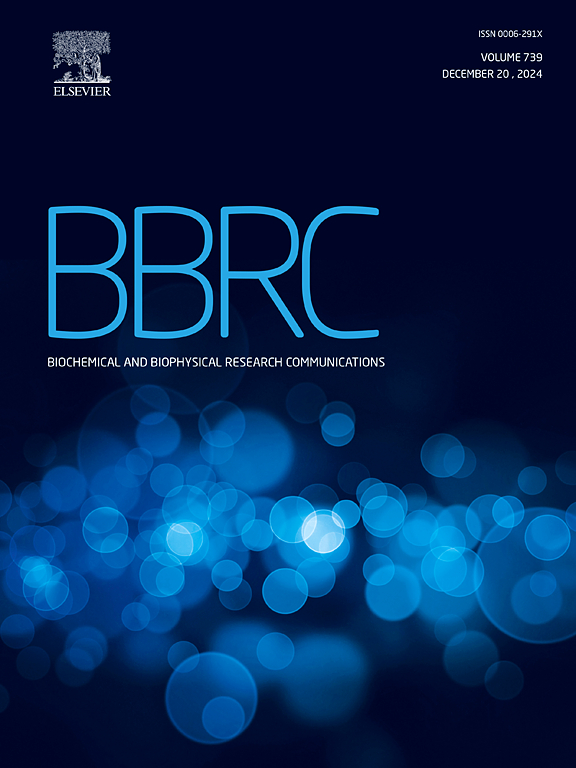胡椒碱衍生物(2E,4E)-5-(苯并[d][1,3]二恶醇-5-基)- n -(2-羟基苯基)五-2,4-二胺通过凋亡对MCF-7乳腺癌细胞发挥细胞毒作用:基因表达和生物分子变化研究
IF 2.5
3区 生物学
Q3 BIOCHEMISTRY & MOLECULAR BIOLOGY
Biochemical and biophysical research communications
Pub Date : 2025-04-25
DOI:10.1016/j.bbrc.2025.151895
引用次数: 0
摘要
乳腺癌是全世界妇女死亡的主要原因之一。系统治疗的化疗药物有不良副作用的报道。因此,乳腺癌的治疗仍然需要新的药物。本研究旨在探讨胡椒碱衍生物(2E,4E)-5-(苯并[d][1,3]二硫醇-5-基)- n -(2-羟基苯基)五-2,4-二胺(1f)对MCF-7乳腺癌细胞的抗癌活性及其机制。结果表明,1f在7.5 ~ 60 μg/mL范围内抑制MCF-7细胞呈剂量依赖性,IC50值为17.02±1.74 μg/mL。其对细胞迁移的抑制作用呈剂量和时间依赖性。此外,它还能诱导细胞凋亡的形态学特征,增加细胞内活性氧(ROS)的水平。磷脂酰丝氨酸(PS)暴露染色和DNA片段化证实了细胞凋亡的诱导。1f诱导TP53、PTEN和CASP9基因表达,而ESR1、BRCA1、BRCA2、PIK3CA、AKT1、CHEK2、BRIP1和KRAS基因表达降低。STRING蛋白-蛋白相互作用网络和KEGG通路分析预测与DNA修复、雌激素受体-α (ER-α)和PI3K/AKT信号通路相关的细胞凋亡诱导。傅里叶变换红外光谱(FTIR)结果表明,1f降低脂质利用率,抑制蛋白质合成,诱导细胞凋亡。总的来说,1f作为乳腺癌的抗癌药物是一个有趣的候选物。本文章由计算机程序翻译,如有差异,请以英文原文为准。
![Piperine derivative, (2E,4E)-5-(benzo[d][1,3]dioxol-5-yl)-N-(2-hydroxyphenyl)penta-2,4-dienamide, exerted cytotoxic activity toward MCF-7 breast cancer cells via Apoptosis: Gene expression and biomolecular change study](https://img.booksci.cn/booksciimg/2025-4/102303253921776697848.jpg)
Piperine derivative, (2E,4E)-5-(benzo[d][1,3]dioxol-5-yl)-N-(2-hydroxyphenyl)penta-2,4-dienamide, exerted cytotoxic activity toward MCF-7 breast cancer cells via Apoptosis: Gene expression and biomolecular change study
Breast cancer is one of the leading causes of mortality in women worldwide. Adverse side effects have been reported from chemotherapeutic agents of systematic therapies. Therefore, new agents are still needed for breast cancer treatment. This research aimed to investigate anticancer activity and mechanisms of a piperine derivative, named (2E,4E)-5-(benzo[d][1,3]dioxol-5-yl)-N-(2-hydroxyphenyl)penta-2,4-dienamide (1f), against MCF-7 breast cancer cell. The results show that 1f ranging from 7.5 to 60 μg/mL inhibited MCF-7 cells in dose-dependent manner with IC50 values of 17.02 ± 1.74 μg/mL. It inhibited cell migration in dose and time dependent manners. In addition, it induced morphological characteristics of apoptosis and increased the level of intracellular reactive oxygen species (ROS). Phosphatidylserine (PS) exposure staining and DNA fragmentation confirmed the induction of apoptosis. 1f induced the gene expression of TP53, PTEN, and CASP9, while ESR1, BRCA1, BRCA2, PIK3CA, AKT1 CHEK2, BRIP1 and KRAS expression were decreased. STRING protein-protein interaction network and KEGG pathway analysis predicted the induction of apoptosis linked with DNA repair, estrogen receptor-α (ER-α), and PI3K/AKT signaling pathways. Moreover, Fourier transform infrared spectroscopy (FTIR) results shows that 1f reduced the lipid utilization rate and inhibited protein synthesis, resulting in the induction of apoptosis. Overall, 1f is an interesting candidate for development as an anticancer agent for breast cancer.
求助全文
通过发布文献求助,成功后即可免费获取论文全文。
去求助
来源期刊
CiteScore
6.10
自引率
0.00%
发文量
1400
审稿时长
14 days
期刊介绍:
Biochemical and Biophysical Research Communications is the premier international journal devoted to the very rapid dissemination of timely and significant experimental results in diverse fields of biological research. The development of the "Breakthroughs and Views" section brings the minireview format to the journal, and issues often contain collections of special interest manuscripts. BBRC is published weekly (52 issues/year).Research Areas now include: Biochemistry; biophysics; cell biology; developmental biology; immunology
; molecular biology; neurobiology; plant biology and proteomics

 求助内容:
求助内容: 应助结果提醒方式:
应助结果提醒方式:


